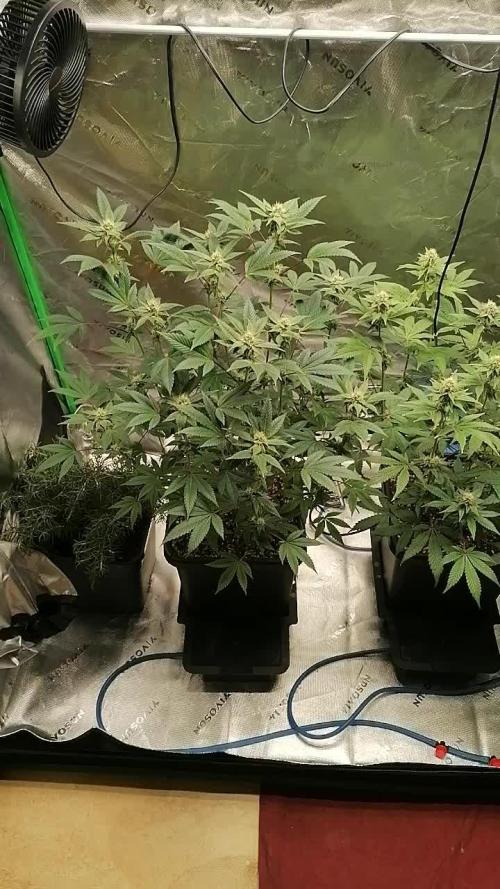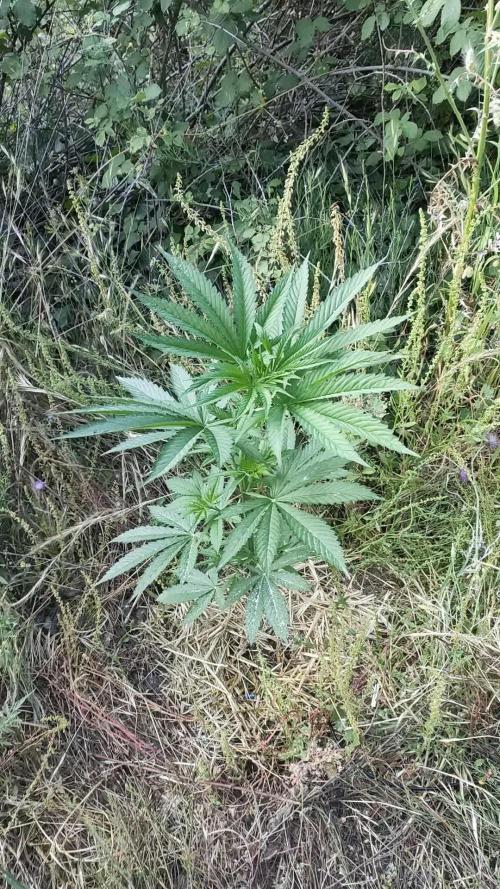By continuing to use the website or clicking Accept you consent to our cookies and personal data policy and confirm that you are at least 18 year old. For details please see Privacy Policy and Terms
Accept
Likes
116
Share


@AsNoriu
Follow
Day 60 since seed touched soil. Twins are running !!! But nice ;) Heavily overcrowded, always sad when missing water, drinks fastest from all 3 now.
Watered girls yesterday. Thinking to do heavy bottom clearing today. Dropped idea of third scrog level. Girls are secured enough and i dont want to loose access totally. Running out of height ...
Distance to light- around 15 cm. Mars TSL2000 works just fine, with open window i keep day temps in 22-24 range.
Took down all LST, cleared bottoms.
Day 62. They run !!!! Already panicking and contemplating idea of taking carbon filter out of the tent. Have 25-30 cm left, space to light like 10 cm ;)))) Tops next to walls starting to drift behind, obviously not right coverage aka distance to light too small, not using all footprint wise ...
Happy Growing !!!
Likes
25
Share


@XperencdGmanXG
Follow
got these clones of wedding cake from a local grow buddy, Thought I had room for them indoors but I was wrong. So outside they go for the year. They really wanted to reach for the sky indoors lets see how they do outdoors!
Likes
17
Share


@Naujas
Follow
it's amazing, this growth looks much better than my first attempt, my decision was to put a smaller pot and change the light - the girl really liked it, FastBuds goriilla cookies with a small space manage perfectly:).
Likes
8
Share


@Brujha77
Follow
Start Woche 5 Blüte.
Scheint ja doch noch etwas dabei rauszukommen nach dem Stress am Anfang.
Hatte echt die Befürchtung das die evtl. Zwittern nach dem hin und her👍
Likes
9
Share


@Prof_Weed
Follow
Okay buds are growing thicker, everything is nearly healthy and i think i will need +6 weeks..
Some burned Tips,i think too much light..
Added X-Cel from Bionova to get bigger
Likes
6
Share


@MadeInGermany
Follow
Hey guys :-) .
Today the plant was sprayed again with neem oil.
There weren't any more trips to be seen after the second application, but to be on the safe side, you did it again today get a cure.
That's why the beautiful dark shimmer on the leaves :-).
The ladies are developing well and have 1 week before I change the time to flowering.
Normally I would let it get bigger and train because the tent only has 80x80 and 180 watts are available, so I will switch it over soon enough.
This week it was poured twice with 0.8 l each time (for nutrients, see table above).
Otherwise everything was cleaned and, as always, everything was checked.
Have fun with the update and stay healthy 🙏🏻
👇🏼👇🏼👇🏼👇🏼👇🏼👇🏼👇🏼👇🏼👇🏼👇🏼👇🏼👇🏼
You can buy this Nutrients at :
https://greenbuzzliquids.com/en/shop/
With the discount code: Made_in_Germany you get a discount of 15% on all products from an order value of 100 euros.
👇🏼👇🏼👇🏼👇🏼👇🏼👇🏼👇🏼👇🏼👇🏼👇🏼👇🏼👇🏼
You can buy this strain at :
Clearwater Seeds
Water 💧 💧💧
Osmosis water mixed with normal water (24 hours stale that the chlorine evaporates) to 0.2 EC. Add Cal / Mag to 0.4 Ec Ph with Organic Ph - to 5.8 - 6.4
MadeInGermany
Likes
Comments
Share


@Ecu_D_Monkey
Follow
Culture facile sans aucun soucis
belle plante tres esthétique
une merveille pour les amateurs de gout fruité
Likes
11
Share


@GREENPHOENIX6262
Follow
Week 2 Flower 09/04
Bllimburn Apple Fritter - Seedsman Critical +2.0
39 - 40inches - Increased Raw NPK feed ( Phosphorus - Potassium ) 2 teaspoons per gallon on each with Cal Mag, Flower Fuel and Floranova Bloom.
Flowering processing accordingly.
*End of week update 09/09*
Both Apple Fritter and Critical are flowering accordingly.
3-4 Inch height increase
Budsites looking healthy - No signs of deficiencies from nute feeds
Main Colas were aggressively LST's to avoid light burn.
Likes
5
Share


@Momgrowsthechronic
Follow
So welcome to the final update prior to harvest and it’s covering Weeks 8 & 9 of the Lemon Pie Autoflowering grow. I fertilized one final time early in Week 8 at 5 mls per gallon and have been flushing with PH’d, air bubbled water ever since. They have begun to yellow out a bit and I have been defoliating as needed. All four of these lovely ladies will be chopped over Week 10 which is within the window of 65-75 days as recommended by Fast Buds. Check in next time for the final pictures, harvest info and smoke report. Coming soon…
Likes
4
Share


@Barcelona_Farmers710
Follow
Muy buenos resultados para el poco cuidado por falta de tiempo! Una maravilla.
Likes
30
Share


@Dunk_Junk
Follow
The buds are fattening up now. Still no amber trichomes. Weather is hot here. Tent seeing 30+c at it's peak. I'm wondering if the heat is stressing her.
Likes
15
Share


@medicalcannabelfast
Follow
This week has flew in , can’t believe I’m on week 5 already :) .
The girls are growing well , allow they are 2 totally different looking plants the smell the same and seem to be maturing at the same rate :)
I can’t wait to see all the little bud sites start to fatten and fill out over the last few weeks
Likes
9
Share


@420DeepGrow
Follow
📆 Semana 8: Expansión Constante
Con solo dos semanas para el solsticio, la planta entra en una fase clave de desarrollo. 🌿
Aprovechando al máximo las horas de luz y el clima benévolo, su crecimiento se vuelve más acelerado y estructurado, con entrenudos que comienzan a alargarse y nuevas hojas que brotan con fuerza y simetría.
La coloración sigue siendo un verde intenso, señal de una nutrición equilibrada y una buena actividad fotosintética. Las raíces, ya adaptadas al nuevo sustrato, alimentan con eficacia cada parte del sistema aéreo. 🔄
Se mantiene el seguimiento preventivo ante posibles plagas o desequilibrios, aunque de momento el entorno se mantiene estable y controlado.
Es una etapa ideal para pequeñas intervenciones de guiado o poda suave, maximizando la forma y la distribución de la energía. ✂️✨
¡Seguimos creciendo fuerte! 💪
Likes
19
Share


@adam_pawloski87
Follow
This week went real well! All 5 of the Twenty20 Ogreberry Autos and the 1 Fastbuds Bruce Banner have successfully germinated and sprouted up from the soil!! This upcoming week we will start giving these girls a heavy feeding of nutrients PH d at 6.5 an see how they react , most likely will love it!! Temperature an humidity has been on point, through out the day we reach 70-75 degrees an a nice humidity of 65%which is always nice ! Hope you all enjoy an keep them eyes peeled for next week !! Peace, love, an positive vibes to all you Growmies out there! If any questions please feel free to ask , more then happy to help! Cheers everybody to another great grow!!!
Processing
Likes
39
Share


@Jubiedude
Follow
Day 1 (day I got plant)
-Placed clone in cup of soil with bottom cut off in larger pot for easy future transplanting. (Pics. 1&2)
-Cut 2 bottom fan leaves off
-Sprayed leaves and soil with water
Day 3
-noticed tiny white spots on some leaves. Looks like spider mites but probably not since I'm in a grow tent and I couldn't see evidence of mites under the leaves (UPDATE Day 5 I added a video of the white dots)
Day 4
-Didnt get to see plant today. Received first watering to overflow of the smaller cup






















